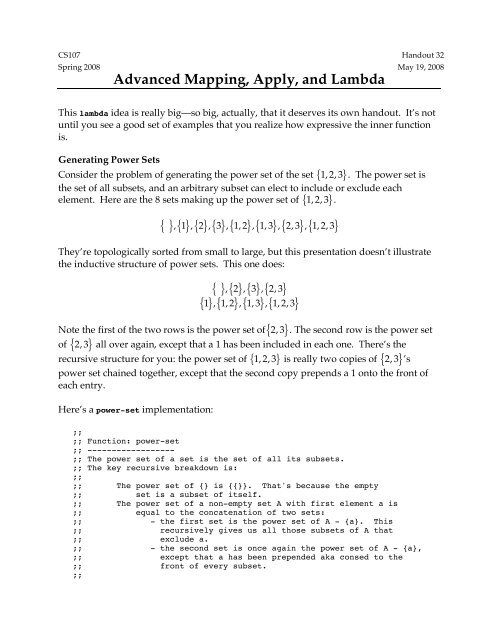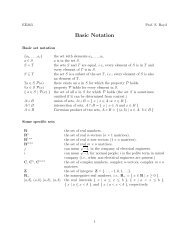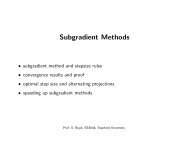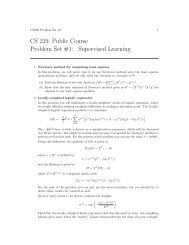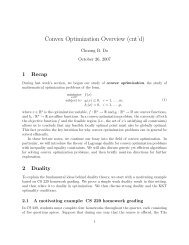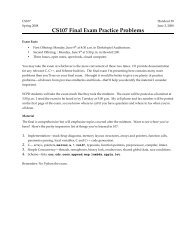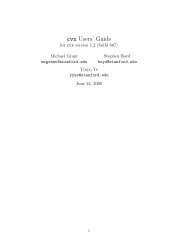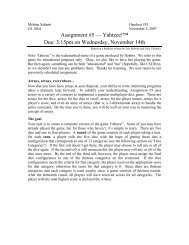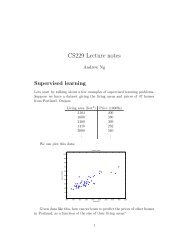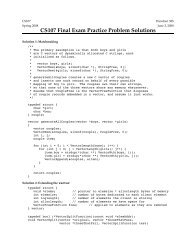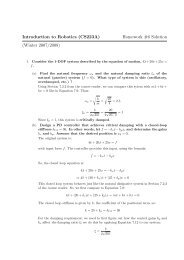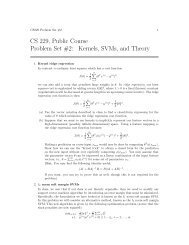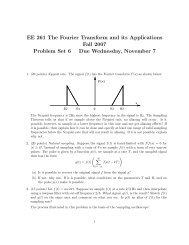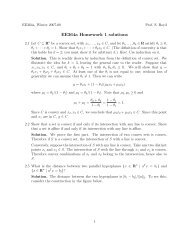Scheme Examples
Scheme Examples
Scheme Examples
You also want an ePaper? Increase the reach of your titles
YUMPU automatically turns print PDFs into web optimized ePapers that Google loves.
2(define (power-set set)(if (null? set) '(())(let ((power-set-of-rest (power-set (cdr set))))(append power-set-of-rest(map (lambda (subset) (cons (car set) subset))power-set-of-rest)))))#|kawa:2|# (power-set '(1 2 3 4))(() (4) (3) (3 4) (2) (2 4) (2 3) (2 3 4) (1) (1 4) (1 3) (1 3 4) (1 2) (1 2 4)(1 2 3) (1 2 3 4))#|kawa:3|# (power-set '("Nils" "Nolan" "Eric"))(() (Eric) (Nolan) (Nolan Eric) (Nils) (Nils Eric) (Nils Nolan)(Nils Nolan Eric))#|kawa:4|# (power-set '(#\a #\e #\i #\o #\u))(() (u) (o) (o u) (i) (i u) (i o) (i o u) (e) (e u) (e o) (e o u) (e i) (e i u)(e i o) (e i o u) (a) (a u) (a o) (a o u) (a i) (a i u) (a i o) (a i o u)(a e) (a e u) (a e o) (a e o u) (a e i) (a e i u) (a e i o) (a e i o u))You know an algorithm is dense when the function comment is twice as long as theimplementation. Note the use of a single let binding to preserve the value of therecursively generated power set. It’s because of the let statement that we reduce adoubly recursive implementation to a singly recursive one. That actually reduced therunning time of the algorithm quite a bit.Of course, the algorithm is cool in its own right. But it’s particularly cool in <strong>Scheme</strong>,because <strong>Scheme</strong> allows the on-the-fly lambda to be implemented in terms of the car thatwas excluded from the recursive call. That’s how the second half is transformed from aset that excludes the first element to one that embraces it.Embraces. How dramatic. You’re rolling your eyes, I know.Moving on. Contrast this implementation to the version implemented in C or C++.They’re both compile time languages where there size of everything needs to be decidedahead of time. In C, you work around the language and use the void *auxData ofVectorMap (and you also make all of the copies yourself.) In C++, you use the functionobject to embed the first element inside so that operator() has access to it when it’sexecuted (and you also make all of the copies yourself.)
PermutationsNow consider the problem of generating all of the permutations of a list. Let’s start witha simple illustration by considering the permutations of 1, 2, 3, 4. They’re listed here infour columns:31 2 3 41 2 4 31 3 2 41 3 4 21 4 2 31 4 3 22 1 3 42 1 4 32 3 1 42 3 4 12 4 1 32 4 3 13 1 2 43 1 4 23 2 1 43 2 4 13 4 1 23 4 2 14 1 2 34 1 3 24 2 1 34 2 3 14 3 1 24 3 2 1Notice that the first column includes all of those permutations that start off with a 1, andthat there are six of them. The second column includes the permutations starting outwith a 2, similarly for columns three and four. Each column has 3! = 6 permutations,because each places some number at the front of every permutation of the other three.What’s been said so far can be framed in terms of mapping. One significant componentof the map is the transformation of each element into the set of those permutations thatbegin with it. The mapping routine, whatever it is, needs to take an element andgenerate a list of permutations. Let’s diagram it.(1 2 3 4)(() () () ())If there are four elements in the original list, there are four elements in the final listgenerated by any call to map. We can concatenate the four lists by applying append justprior to exit. That means we have a partial implementation, and it looks like this:(define (permutations items)(if (null? items) '(())(apply append(map function-to-be-determined items))))This mapping function isn’t exactly trivial. It needs to transform an isolated element intoa list of permutations, where every permutation in that list begins with said element. Wecan write it as a lambda function, which recognizes that its incoming argument is theelement that needs to be at the front of all the permutations it generates. In order togenerate those permutations, it must remove the element from the list, recursively
4generate all of its permutations, and then map over that list so it can cons thedistinguished element on to the front of each of its permutations. Let’s write astandalone lambda that assumes that items is in scope.(lambda (element)(map another-function-to-be-determined (permutations (remove items element))))The <strong>Scheme</strong> standard doesn’t require a remove function, and Kawa doesn’t provide oneeither, so we need to write our own. But we certainly know what it’s supposed to do, sowe’ll just pretend it’s a built-in and worry about it later.This inner mapping function is easier… it just needs to cons the incoming element to thefront of each permutation produced by the recursive permutations call. Assuming thatelement is in scope, another-function-to-be-determined can be replaced by:(lambda (permutation)(cons element permutation))Now we put all of this together, to get one mean looking function. (There are dottedlines surrounding the two lambda functions we wrote, so you have an easier time seeinghow far each one stretches.);;;; Function: permutations;; ----------------------;; Generates all of the permutations of the specified list, operating;; on the understanding that each of the n elements appears as the first;; element of 1/n of the permutations. The best approach uses mapping;; to generate n different sets, where each of these sets are those;; permutations with the nth element at the front. We use map to transform;; each element x into the subset of permutations that have x at the;; front. The mapping function that DOES that transformation is itself;; a call to map, which manages to map an anonymous cons-ing routine;; over all of the permutations of the list without x. This is;; as dense as it gets.;;(define (permutations items)(if (null? items) '(())(apply append(map (lambda (element)(map (lambda (permutation)(cons element permutation))(permutations (remove items element))))items))));;;; Function: remove;; ----------------;; Generates a copy of the incoming list, except that;; all elements that match the specified element in the equal?;; sense are excluded.;;
Implementing mapWe’ve already taken a shot at this, but we only managed to write the unary version of it. Itwasn’t an unreasonable thing to do at the time, because most map calls are unary anyway,and it provided an easy-to-understand example of how functions can be passed around asparameters.The implementation of generic-map is intended to truly imitate the built-in. The onlydifference: we’ll assume that all lists are of the same length, just so we can focus onimplementation and not so much on error checking. Let’s reproduce the implementation ofunary-map here, because we’ll be using it in a second.(define (unary-map fn seq)(if (null? seq) '()(cons (fn (car seq)) (unary-map fn (cdr seq)))))In order to accommodate a variable number of lists, we need to learn the <strong>Scheme</strong> equivalentof C’s ellipsis. Because generic-map requires a function and one or more lists be supplied,the first line of its define statement needs to look like this:;;;; Function: generic-map;; ---------------------;; Relies on the services of the unary-map function to;; gather the cars of all the lists to be fed the supplied;; fn, and then gathers all of the cdrs for the recursive call.;;(define (generic-map fn primary-list . other-lists)implementation coming soon)The . separates the required arguments from the optional ones. fn and primary-list arerequired, but arguments beyond primary-list are not. All of the additional arguments,whatever they are, are bundled together in a list called other-lists. When we evaluate(generic-map * ‘(1 2 3) ‘(10 20 30) ‘(100 200 300)), fn inherits whatever code wasattached to *, primary-list is tied to (1 2 3), and other-lists is bound to((10 20 30) (100 200 300)).7
Here’s the implementation of generic-map, which uses unary-map to extract the cars and thecdrs from the lists inside other-lists.;;;; Function: generic-map;; ---------------------;; Relies on the services of the unary-map function to;; gather the cars of all the lists to be fed the supplied;; fn, and then gathers all of the cdrs for the recursive call.;;(define (generic-map fn primary-list . other-lists)(if (null? primary-list) '()(cons (apply fn (cons (car primary-list) (unary-map car other-lists)))(apply generic-map (cons fn (cons (cdr primary-list)(unary-map cdr other-lists)))))))The first apply expression levies the mapping function of interest over all of the cars.Note that unary-map is used to collect the first elements of list two onward. The car ofthe first list is prepended to that so that all of the arguments are lined up like ducks in alist and the first apply call works.The arguments for the recursive call are more easily assembled into a list (even the codeattached to fn is placed in the list), and that’s why generic-map is applyed instead ofbeing invoked by name. Constructing the list of arguments for the recursive apply istricky, because all of the cdrs—including those of primary-list and within other-lists,need to be reestablished as peer lists, just as they were in the initial call.#|kawa:2|# (generic-map cons '(1 "a" #\x) '((2 3) ("b" "c" "d") ()))((1 2 3) (a b c d) (x))#|kawa:3|# (generic-map * '(2 3 4) '(40 20 30) '(300 400 200))(24000 24000 24000)#|kawa:4|# (generic-map (lambda (fn data) (fn data))#|(---:5}# (list factorial fibonacci power-set permutations)#|(---:6)# '(6 10 (1 2 3) (a b)))(720 55 (() (3) (2) (2 3) (1) (1 3) (1 2) (1 2 3)) ((a b) (b a))))8


